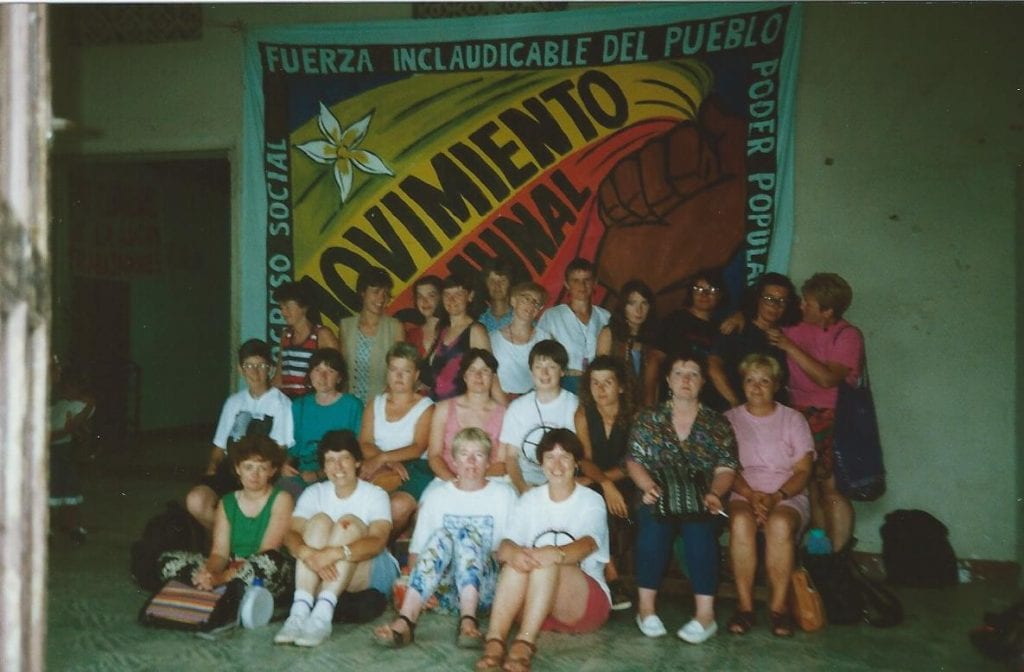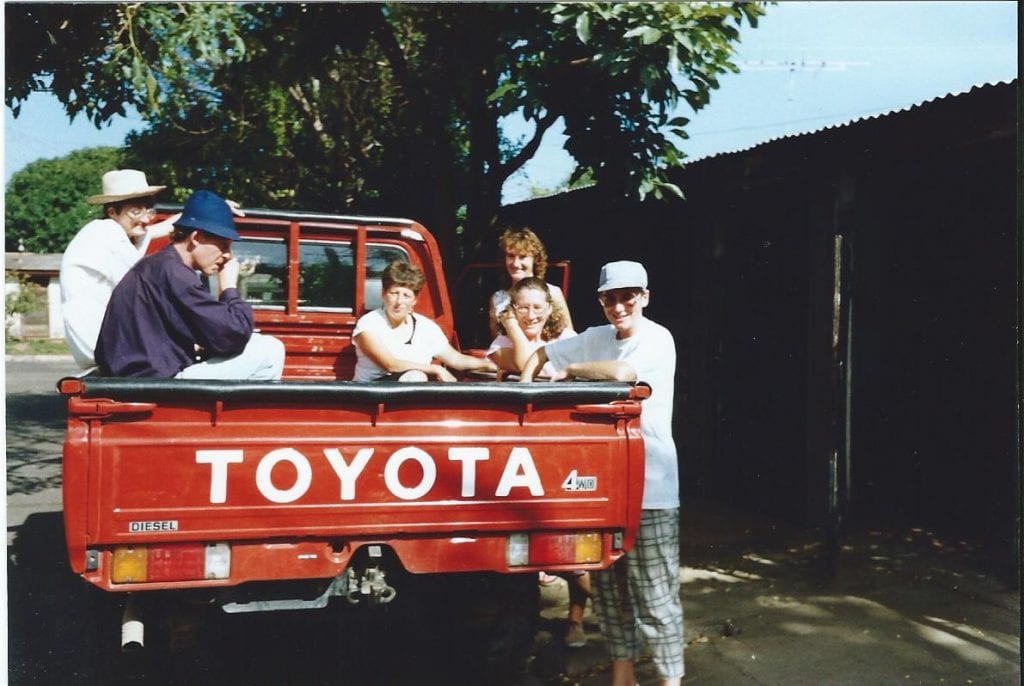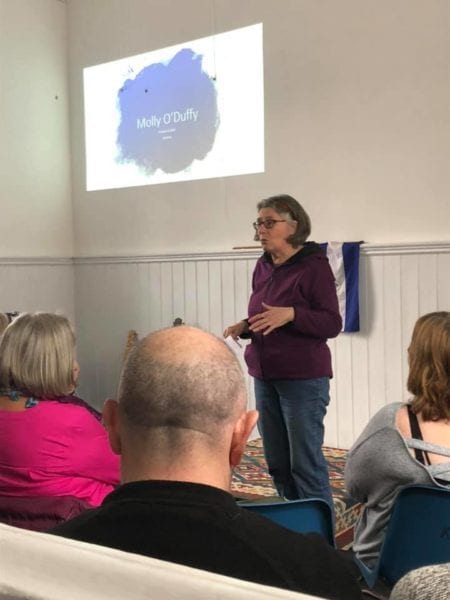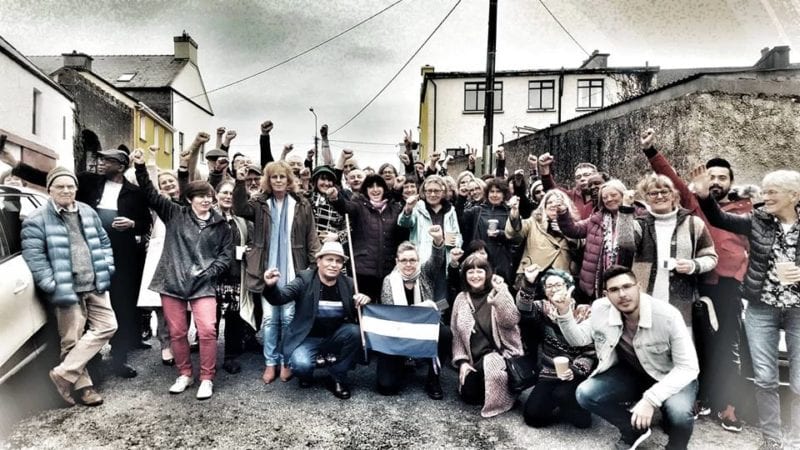Irish Who Traveled to Nicaragua in Solidarity Send Out SOS
The Nicaraguan people continue to struggle for democracy and justice – only this time against a surprising enemy.
By Molly O’Duffy*

HAVANA TIMES – Back in the 1980s thousands of Irish people backed the Sandinistas in Nicaragua – after they overthrew the dictator Anastasio Somoza.
I took part in fundraising and awareness-raising activities here in Ireland and in 1988, I was one of more than 150 Irish people who travelled to Nicaragua to support the Sandinistas, as part of the Solidarity Brigades, sometimes known as the coffee brigades.
We went to lend a hand to local farmers by picking coffee as well as to offer friendship and support to the local people.
At that time the gains of the revolution, chiefly universal literacy, land reform and wide access to education and healthcare, had vastly improved the lives of the poor people in Nicaragua.
But a US-backed war against the Sandinista government had led to compulsory military service, which was increasingly unpopular. I witnessed many reluctant men being driven to the front, many of whom came back maimed or in coffins.
The US economic embargo caused shortages and hardship and had led to cuts in essential services. The people were tired.
Daniel Ortega was a leader of that revolution and the president – he still heads the Sandinista National Liberation Front to this day. But that organization has changed beyond anything we could have imagined in the 1980s.
The rot started in 1990 when leading party figures plundered state resources for personal gain before handing over power after losing an election.
Then during the nineties, Ortega moved to eradicate democracy within the party and entered into political pacts with right-wing parties aimed at carving up power.
As a result, many members left his party, including the majority of the commanders who had helped to bring about the defeat of Somoza. Along with the former Sandinista Vice-President, they established an alternative – the Movement for Sandinista Renewal (MRS).
Control
When Ortega regained the presidency in 2007 a friend of mine who was a member of MRS said to me: “He will come after us all.” How right she was.

Ortega has amassed huge personal wealth based on control of the energy and telecommunications industry, as well as privatizing the support offered to the country by Venezuela.
He has managed to control the four pillars of democracy: the judiciary, which he uses to punish critics; the electoral commission, which he has used to run fraudulent elections; the parliament, which obediently passes laws that promote his interests and bans any party that might compete with his ruling FSLN party.
He controls the executive through his wife, who is the vice-president and he has changed the constitution to allow himself to stay in power permanently.
The human rights record of his government has been very poor, with Amnesty International documenting appalling prison conditions and attacks on peaceful protesters.
A 15-year old boy that I know was tortured in prison in 2016.
Ortega has satisfied all the conditions to secure loans from the IMF. He forged alliances with big business and has silenced all voices not controlled by his party except for a few small media outlets that are under constant attack.
But he has also carried out some social programs that proved popular. His iron control of the country has also meant that the drug traffickers and gangs, that have terrorized the population of neighboring countries, have not succeeded in achieving a strong foothold in Nicaragua.
These factors may help to explain why the population was fairly acquiescent during many flagrant electoral frauds, cases of corruption, police and army violence and non-stop propaganda from the government – but on 18 April 2018 that changed when peaceful protests took place.
Peaceful protests
Ortega’s implementation of an IMF-recommended reform of the social security system served as the trigger for the current protests, which were led by university students.
However, it was not so much the proposed changes that led to widespread anger but the suspicion that the social security fund had been looted by a member of Ortega’s family.
Other contributing factors were government inaction in the face of a massive wildfire in an important ecological reserve, and a threat by the vice-president (Ortega’s wife) to ‘regulate’ social media.
The peaceful demonstrations of April 18 were fired on by police.

[pullquote]
Festival in Exile event held for Nicaragua
On Saturday February 16th in the picturesque village of Kinvara in the West of Ireland 60 people crowded into a small hall for the “Granada poetry festival in exile”. There was poetry, song, talks about the current crisis, particularly the situation of political prisoners and exiles.
Those who had gone to Nicaragua in solidarity with the Sandinistas in the eighties and those who had met Ortega during his visit to Ireland in 1988 expressed their revulsion at the repression unleashed by the Ortega-Murillo government.
The meeting agreed the Kinvara Declaration calling on the government to release all political prisoners and renew the national dialogue so that the current human rights nightmare can be brought to an end.
[/pullquote]Over the first five days of protests 30 people were killed.
Arising from these killings, a wide opposition coalition was formed, consisting of students, civil society, the women’s movement and employers, now demanding the exit of Ortega and his government. As the protests spread, the death toll has mounted. Government-backed forces have opened fire on peaceful protestors.
Police, backed by government-supported gangs, roam the streets at night, killing, injuring and kidnapping people thought to be engaged in the protests.
The death toll is in the hundreds – the dead are mostly young men and students, but also include women, children and babies. Thousands more have been seriously injured.
There have also been many arrests, with 600 people still detained while 300 others have been charged with serious offences, including terrorism. Many released prisoners have been tortured and the ‘disappeared’ whose bodies have been found at the side of the road also show evidence of torture.
In recent months Ortega has waged war against the independent media with many journalists in jail or forced into exile.
He has been criticized by human rights bodies, including Amnesty International, the Organisation of American States and the UN High Commission on Human Rights – which hasbeen expelled from the country because of their negative findings against the government.
The UN Security Council and the Organization of American States have both attempted to intercede with Ortega to stop the repression, to no avail.
Alleged conspiracy
The government alleges that the uprising is ‘coup-mongering’. The product, variously, of a conspiracy by the US, the Catholic Church, ‘satanic forces’ or the narcos and gangs.
However, the head of the Supreme Court, Rafael Solis, the man who previously masterminded all of Ortega’s maneuvers to gain complete control of the country,resigned his post in January and his party membership.
Solis said that there is no coup and that the political prisoners are innocent peaceful protesters. He said that the long sentences being handed down to protestors for ‘terrorism’ are being dictated by Ortega.
The reality is that 80% of the population now oppose Ortega, according to a recent survey by transparency organization Etica y Transparencia.
There have been pleas for restraint by the international community and from many international left-wing figures, including Noam Chomsky.
A surprising enemy
It is estimated that Ortega’s apparatus consists of approximately 1,000 people, many with so much corruption and violence to their name that they will fight to the end to protect the regime.
This is not a war, but a massacre by a criminal regime against an unarmed population that wish to have a say in how their country is run.

The UN estimates that up to 50,000 people have gone into exile in neighboring Costa Rica, among them Carlos Mejia Godoy, the troubadour whose emblematic songs accompanied the struggle against Somoza, and the entire staff of the Nicaraguan Pro-Human Rights Association, all threatened with death for their defense of the unarmed protesters.
Others, particularly campesinos (small farmers) young people and students, are in hiding from the state in safe houses or in the jungle. Many of those who have been affected by the violence were supporters of Ortega prior to the events of 18 April 2018.
The message for Irish people who supported the Nicaraguans in the 1980s in their struggle for social justice, and who identified with the Sandinista cause, is that the majority of Sandinistas now support the protest movement, not Ortega’s government.
It is estimated that 70% of the political prisoners have Sandinista origins.
My Nicaraguan friends are afraid to leave the house. The generation that fought with Ortega against Somoza feels guilty that they were outwitted by him, resulting in so much suffering for their children.
The Nicaraguan people continue to struggle for democracy, justice and fairness – only this time against a surprising enemy.
They deserve our solidarity today just as they did in the past.
—–
*Molly O’Duffy is a former Solidarity Brigade member and a member of the Latin America Solidarity Center in Dublin.
This article was orginally published in the thejournal.ie.






I appreciate the information and analysis from the Irish Nicaraguan Solidarity group. It is more detailed than other news coming out of US sources or even Nicaraguan ones.
You are not capable of informed discourse, you try to insult people who dont agree with you, just like Trump.
Thank you for a good overview.
The degeneration of the FSLN into an authoritarian, corrupt political party run by a family clique is a tragedy for Nicaragua and the world community who supported them in the 70’s and 80’s.
As well as you I share the vision of equality and I thought the sandinistas were the one who can bring that to the Nicaraguans people . But it was far to be true.
He becomes the dictator that we had ever experienced. The most repressive government Nicaraguans had never had . God save Nicaragua
I felt pleased to read the perspective and contribution from your group. Thanks.
I live here in San Juan del Sur.
Would be honored to have tea with any of your existing members.
Shame on you for supporting this murderous regime. I was born and raised in this country, and I assure you that the Ortega/Murillo alliance is far, far worse than the Somozas EVER were! Now you have reaped what you’ve sown…at the cost thousands of lives. That figure comes from the multiple murders of many indigenous people living in so-called “protected areas”, killed by marauders who came to steal their lands ?.
D.W. Watts,
You are a SIMPLETON. Have another drink and post something about Obama being a foreign bred communist Islamist or something. Moron.
Very well spoken. But for the last part, let the dice fall as they will. People have to make ethical choices. Or NOT.
This is the best of the articles I’ve seen on the struggle in Nicaragua. I agree wholeheartedly with this perspective. The political involvements of the past, true or simply alleged aren’t at issue anymore in the face of today’s events. But once again, history repeats itself. The rant: The only difference between the Ortega-Murillo regime and that of Adolph Hitler, is that pre-war Germany had built a physical and economic infrastructure prior to launching the atrocities of that time. Nicaragua, while far from being the “poor developing nation” that most believe, has many resources and significant wealth which has been controlled, misappropriated, squandered, and hoarded by Ortega, his wife, his cronies, and almost all of his children who control a significant portion of the wealthy businesses in Nicaragua. Both Ortega and Hitler had created their informant networks to censor, terrorize, and incarcerate the opposing populace, of which the latter is utilizing daily. Every barrio in Managua, has numerous informants loyal to the regime who provide information to the police which results in more protesters incarcerated daily. Reminiscent of the Hitler Youth, right? Only this time it’s mostly the youth who are being persecuted. The other cities and districts are similarly fashioned so that the government has eyes almost everywhere. So when you refer to the loyal 1000 or so who supporting this regime because they’re in it up to their knees anyway, you can’t leave out the thousands who participate in the reporting process and, in many respects, are as culpable, for the incarceration, torture, and deaths as those they report to. So the collateral damage done along the way to Ortega’s ultimate downfall is tragic and enough to make one’s blood boil, but what will happen to the wealth and resources stolen from the Nicaraguan people by this family and their associates? While we all want to see an end to the pain and struggling in this country, there should be accountability for all who contributed to this atrocity, right? I fear the ‘witch hunt’ will be ugly.
There was no election in 2003. Ortega was elected at the end of 2006 and took office on January 10, 2007.
George Bush didn’t accept Daniel Ortega winning the election back in 2003. Since then the the US administration has harrassed Nicaragua. The NICA act is the last act of aggression.
Not exactly D.W., Reagan claimed that the Sandinistas in communist Nicaragua were “only 48 hours from Texas”, trying to scare people into believing this poor little country was a threat and aggresor to the United States. It’s interesting that Reagan’s latest stand in, Donald Trump, calls poor immigrants a lot of names and says they are a threat to US security. The old anti-communist domino theory now in its terrorist, rapist remake. The falseness back then and now of these presidents has nothing to do with the moral and ethical decay of Daniel Ortega and those around him.
Basically, you use many words to say that Ronald Reagan was 100% accuarate about the Sandinistas and you helped create this monstrosity in Nicaragua.